10 Fascinating Moments from the 2023 Hawaii Ironman World Championship
This article originally appeared on Outside
Lucy Charles-Barclay waited approximately zero seconds before making her move at the 2023 Hawaii Ironman World Championship on October 14, 2023. Powering through the choppy waters of Kailua Bay with her characteristic snappy glide, the 30-year-old British triathlete gapped the field by nearly 350 meters--almost four football field lengths
Charles-Barclay lead off the front for the next 140.2 miles of swimming, biking, and running, breaking the tape in a record-setting 8:26:18 for her first world title.
RELATED: Visit Triathlete‘s Hub for the 2023 Ironman World Championship Kona, Women
A four-time runner-up in 2017, 2018, 2019, and 2022--the victory was a long time coming.
"If there was any way I wanted to win this race, it would have been like that," Charles-Barclay . "There were many times when I thought I would always be the bridesmaid in Kona. It's nice to finally be the bride."
Her win is just the start of jaw-dropping moments from the inaugural women's-only Ironman World Championship in Kailua-Kona, Hawaii. (The inaugural men's-only Ironman World Championship was held on September 9 in Nice, France.) From a run course record set by only fueling with protein to a series of historic firsts, here are our top 10 takeaways from one of the most important races in endurance sport.
1. Charles-Barclay Vanquishes Bridesmaid Curse
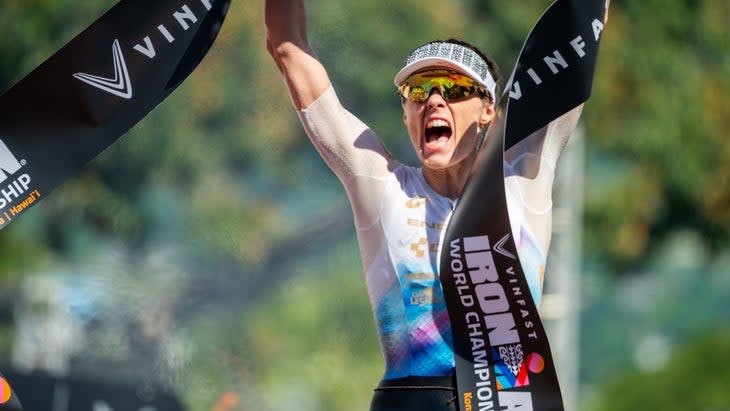
By earning the crown on Saturday afternoon, Charles-Barclay solidified her name on the list of Kona legends and broke a series of records--including the women's course record previously held by Switzerland's Daniella Ryf when she clocked 8:26:18 for the win in 2018.
No woman has led the wire-to-wire since Lyn Lemaire, the first woman to ever win the race in 1979. Charles-Barclay broke that 44-year streak after coming out of the water with a four-minute advantage. She also etched her name in history as only the second person ever to win the Hawaii Ironman World Championship after winning an amateur age group title here, which she claimed in the 18-to-24-year-old division in 2015.
Decked in a mermaid race kit that extended from the blue and grey scales painted on her Red Bull helmet to her custom sea-blue CUBE Aerium C:68X time-trial bike, Charles-Barclay raced like someone who not only wanted to win, but even more so did not want to lose. She blitzed the 112-mile bike in 4:32:29, averaging over 24.7 miles per hour to further extend her lead over the competition.
In past years, Charles-Barclay's blistering early pace has come back to haunt her on the run. Not on Saturday. She held on for respectable 2:57:38 marathon and a hefty three-minute lead. But it wasn't until the finish chute loomed into sight on Ali'i Drive that Charles-Barclay allowed herself to comprehend what was happening.
"I really tried not to put not wanting to be second again in the back of my mind," she said. "I was still looking over my shoulder when I turned onto Ali'i. I didn't believe I would get the win until I broke the tape."
As always, there's more to the story than meets the eye. Charles-Barclay's seemingly assured success obscures the obstacles she had to overcome this year just to get to the start line.
2. Charles-Barclay Breaks Foot and Breaks Records
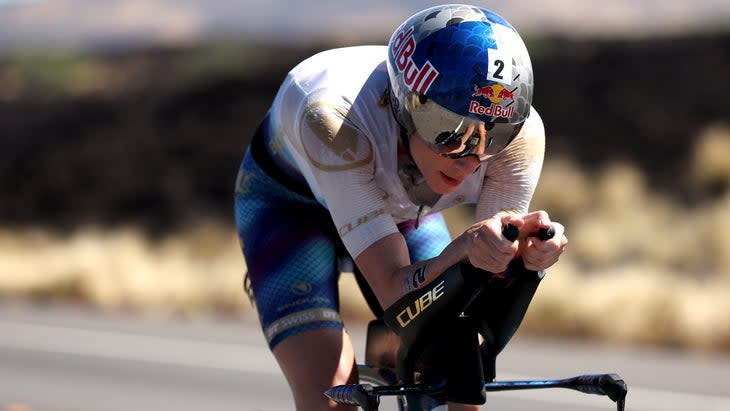
In May, Charles-Barclay felt something in her foot while running into the water at the start of Ironman 70.3 Kraichgau in Germany. She thought little of it. She powered a slew of bike issues and mounting pain on the run to take second in that half-distance Ironman race. An X-ray the next day confirmed she'd snapped the third metatarsal in her foot, a zig-zag fracture all the way through the bone.
For better and for worse, she was no stranger to that type of news.
"It's been a really tough couple of years," Charles-Barclay said. "When I turned 28, I felt like my body didn't want to do this anymore."
Charles-Barclay retreated to her "pain cave" gym at her home in Chingford, Essex, where she cranked up the music, visualized the helicopters circling overhead in Kona, and nearly hit the 2024 Great Britain Olympic qualification mark on the indoor rower while wearing a "moon boot" cast.
Out on the Queen K Highway on Saturday, Charles-Barclay channeled those endless hours of monotony in the pain-cave. She credits that mental toughness training as well as the efficiency of riding the bike trainer indoors (no coasting on the downhills!) to her success, as well as her satisfaction.
"All I ever wanted was to win this race," Charles-Barclay said. "I don't feel like I need anything else anymore. That is the biggest prize, and a credit to the work we've all put in as a team. And they've all put up with me these last few months as I've been very tired and very grumpy, and all my friends and family putting up with that, and that means so much to me during this crazy endeavor to win this race."
3. Anne Haug's No-Carb Fueling Leads to Fastest Run Split Ever
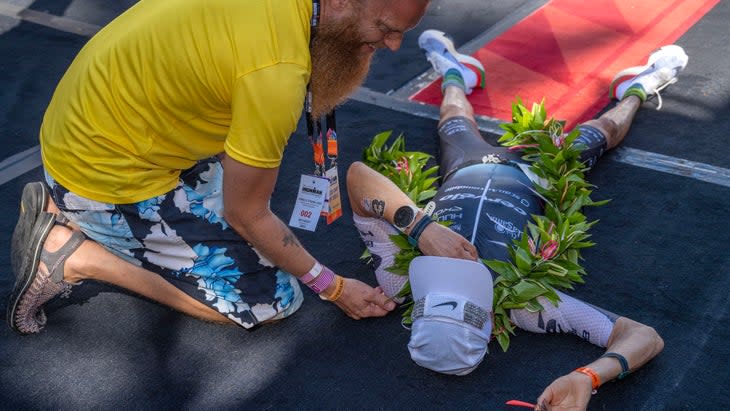
With one of the deepest pro fields ever--particularly on the running front--we knew that if the conditions aligned, we could witness a run for the ages. Sure enough, as soon as she hopped off the bike and slipped into her Nike Air Zoom Alphafly Next% super shoes, Germany's Anne Haug was on a mission. The runner-assassin started the marathon in seventh place overall, 12 minutes back from the lead. But Haug remained composed and got to doing what she does best: passing people on the Queen K.
Haug clicked into her characteristically high cadence, butter-smooth stride, ticking sub-6:20 miles early in the marathon to reel in the field. At mile 18, deep in the heart of the lifeless Energy Lab, Haug decisively passed American dark-horse rookie Taylor Knibb to move into second.
The lead Charles-Barley carved on the swim and the run proved too large to surmount, with Haug ultimately running out of real estate to claim another world title. But in that attempt, she smashed Miranda Carfrae's run course record of 2:50:38 set 2013 when the Australian won the race. Haug clocked in at 2:48:33, averaging 6:25 per mile through the oppressively thick, still air and road temperatures soaring above 100 degrees.
"The run always means a lot to me, and I always aim for a fast run," said Haug, who owns a 2:36:13 open marathon personal best. "I'm absolutely happy. I couldn't have done any better. Lucy was unbeatable today."
The 40-year-old's performance is even more remarkable this year in the face of the health and nutrition obstacles she'sovercome. Over the past several years, her body has grown intolerant to absorbing carbohydrates while racing. Rigorous testing and experimentation with her team in Germany led to the realization that she could only fuel adequately with the right types of proteins and amino acids.
Haug overhauled her entire nutrition strategy, saying she was careful to consume enough on the bike and fueled almost exclusively on protein during the run--a feat nearly unheard of in elite marathoning.
4. Rookie Taylor Knibb Shows America's Future is Bright
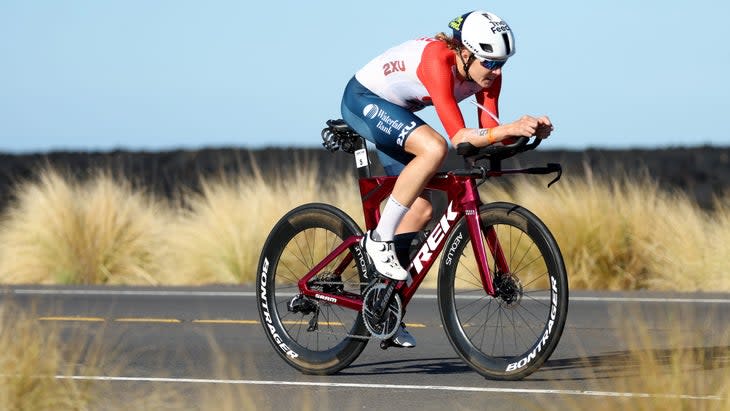
Leading up to Saturday, all eyes were on U.S. Olympian Taylor Knibb. The 25-year-old based in Boulder, Colorado, has been on fire this year, winning the hotly contested PTO U.S. Open to the tune of $100,000 in prize money, defending her Ironman 70.3 world title in Lahti, Finland, and earning bragging rights as one of the world's best short course, draft-legal and long-course triathletes. That range puts Michael Phelps to shame.
But Kona hits different, and despite watching her mom race here five times previously, Knibb had never toed the line herself. In fact, she'd never run above 19 miles. Ever. Would she be able to hang in the heat and humidity over the 140.3 distance?
"What challenges arise and how I overcome them will be the measure of success for me," Knibb said in the days before the race.
That attitude proved prescient.
Knibb swam strong with the front chase pack, but she lost three nutrition bottles on the bike--the third caught by race officials and resulting in a one-minute penalty. Yet Knibb remained composed, chatting and laughing with the motorcycle film crew, thanking volunteers at aid stations, and taking her time at the turn-around aid to dismount from her bike, riffle through her special needs bag, and grab more fuel for the road. Even with the penalty, Knibb had the second-fastest bike split of the day in 4:34:00.
Ultimately, Knibb cracked under the run distance, slowing to a walk intermittently over the final seven kilometers. Her 3:05:13 marathon wound up as the 10th fastest among the pro women in the race. But her final time of 8:35:56 was good enough for an astonishing fourth place--just one minute off the podium and a time that would have been fast enough for the win in all but three other years.
Knibb will return her attention to short-course racing for a bit (the Paris Olympics loom just 10 months away), but watch out the next time the women race here in 2025. She'll be armed with experience and a kind, quippy vengeance--Taylor's version.
5. Americans Shine with Five in Top 10
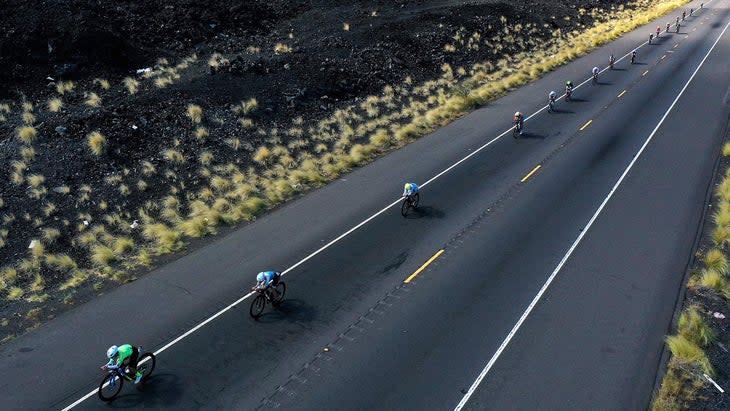
Germany crowded the podium, with Haug taking second and her compatriot Laura Philip racing tenaciously for third. After those three first steps, the show belonged to the United States.
Along Knibb in fourth, the U.S. took five of the top 10 spots. Last year's champion Chelsea Sodaro recovered from a disappointing first two-thirds of the race, in which 19 women out-biked her, to run a solid 2:53:02 marathon that moved her up to sixth. Compatriot Skye Moench finished just a minute later in 8:43:34.
Full-time graduate student Sarah True spent much of the week leading up to the race working on a research paper. She ended up asking for an extension on Friday--a choice which seemed to pay off with her best-ever eighth-place finish in 8:47:06 as she "played triathlete" for the day. An exceptionally strong bike from Jocelyn McCauley was enough for her to hang on during the run for 10th in 8:50:39--the fifth American and third American mom in the race, along with Sodaro and True.
6. Sixteen Women Break Elusive Nine-Hour Mark
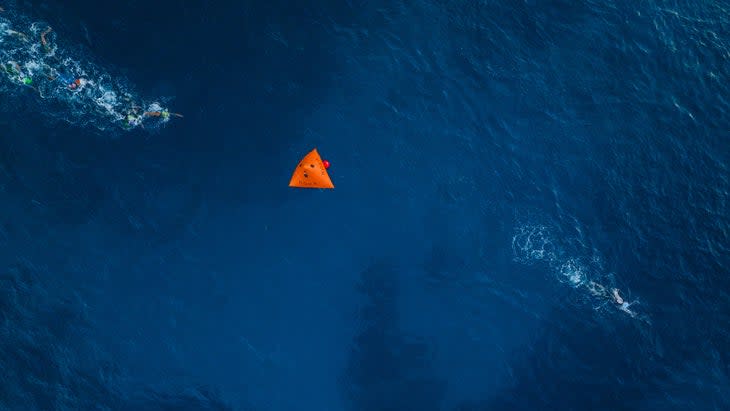
It wasn't until 2009 that four-time Ironman World Champion Chrissie Wellington of Great Britain broke the nine-hour mark on this notoriously hot, humid, and all-around hellish course. Until 2018, you didn't always have to crack nine hours to earn a podium spot. We have officially said goodbye to those days.
Forget the podium, or even the top 10, with a nine-hour time. An unprecedented 16 women dipped under that elusive nine-hour mark this year. Women at the top of the race attribute the fast times to a combination of technology improvements--aerodynamic helmets, bikes, and race kits; wind-tunnel testing; supershoes--and steel sharpening steel.
"We push each other, and we always try to get better," said four-time Ironman World Champion Ryf, who took fifth on Saturday. "The technology has also helped. We've gotten more aero, and materials play a role. But so does pushing each other. I've learned so much from my competitors like Miranda Carfrae."
7. Forget Bikes. It's All About Shoes.
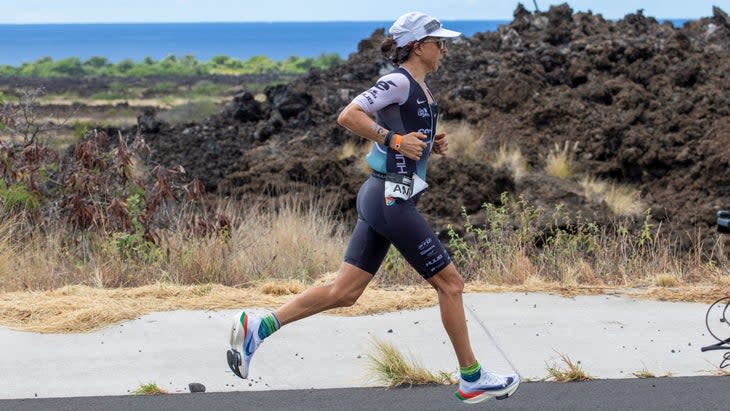
Don't get us wrong, at 112 miles long and taking up about 50 percent of the race, the bike leg remains indisputably paramount. But the impact of rapid fast shoe technology advancement over the past several years cannot be discounted here--both for racing and recovery at the Ironman distance.
All of the top 10 women elected to wear carbon-plated supershoes, including two prototypes on the feet of Ryf (sponsored by Hoka) and Sodaro (who runs for On).
Charles-Barclay held on for her best Kona run ever in the ASICS Metaspeed Sky+. She attributes the advent of supershoes to helping her whittle down her race times, as well as bounce back from injury.
"I guess obviously when I first started racing in Kona, we weren't running in carbon-plated shoes," she said. "But over the years that technology has developed, and I’m super happy in the shoe that I run in. They’ve helped me through the injuries that I’ve had, and yeah, I guess hopefully, like Anne has shown, we are just gonna keep running faster and the technology will help us to do that."
8. All-Women's Field Yields Historic Finisher Rate
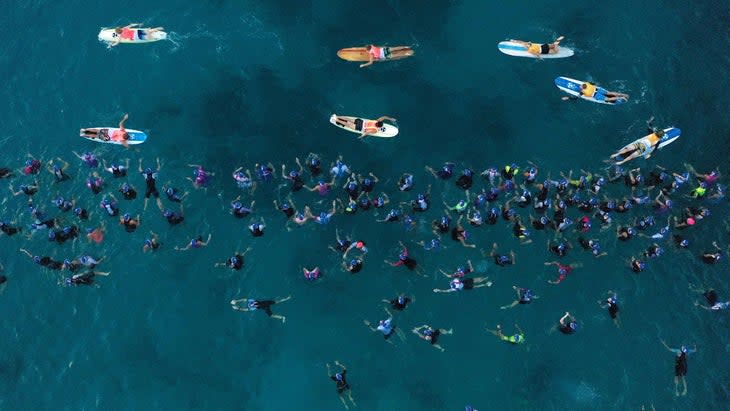
Despite Ironman moving to an all-women's field and giving out more entry spots this year, we already knew that the caliber of the field was as competitive as ever. On Saturday, the women proved they are also grittier than ever. Every single athlete who entered the swim completed the 2.4 miles straight out and back into the Kailua Bay chop. It's potentially a first in the history of the event.
Of the 2,097 starters, 2,039 crossed the finish line in under the 17-hour cutoff. That's an astonishing 97.23 percent finishing rate at one of the most physically and psychologically grueling race courses on Earth--up from the typical 93 to 97 percent finish rate here.
9. Autistic Athletes Make History
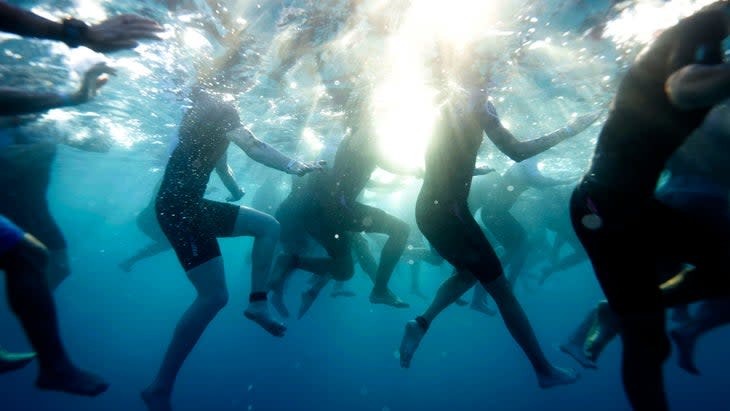
By each completing the race in twelve hours and change, Lisa Cloutier, Marylne Stutzman, and Adrienne Bunn, of the U.S., became the first three openly autistic athletes to cross the finish line at the Hawaii Ironman World Championship.
At 18 years old, the minimum age for entering the race, Bunn also earned the title of youngest finisher this year. Diagnosed with autism spectrum disorder at age four, Bunn started running in school to occupy her thoughts and calm her mind. She started racing triathlons two years ago through a Special Olympics pilot program and earlier this year finished her first Ironman 70.3 race to earn her spot in Kona.
"Running totally transformed her," Bunn's mother, June, said. "It just calmed her--it took away her anxiousness."
On the road to the finish line, Bunn balanced up to 20 hours of training a week with her studies as a high school senior.
"Adrienne got a lot of no's--no way, it's not going to happen," June said. "We never put a ceiling on her. You say it's not going to happen, she's going to prove you wrong."
10. 'We Never Give Up'
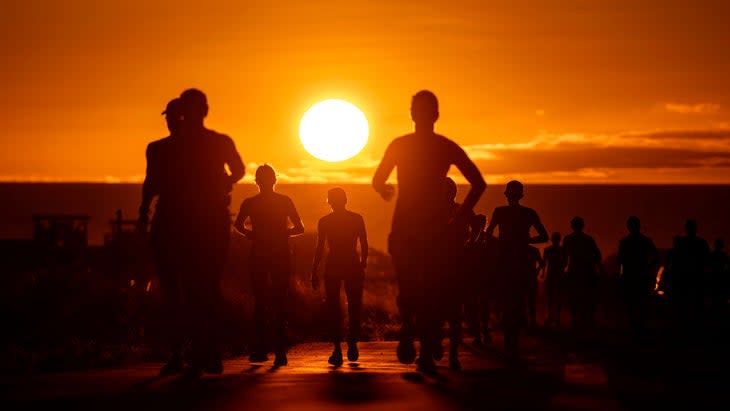
Athletes represented 73 countries at the Ironman World Championships this year, including twelve finishers from wartorn Israel and four from Ukraine.
In addition to the psychological stress these athletes faced, many surmounted logistical nightmares to just make it to the Kailua Pier. Ukraine athlete Yuliya Azzopardi drove 1,000 miles from her home in Kyiv to the border of Poland while abiding by country's midnight-to-5 P.M. curfew, passed through two border controls, and took two flights to make it to the Big Island. As athletes checked into their return flights after the race on Sunday, several major airlines informed passengers that flights to Tel Aviv, Israel, were suspended in the face of the ongoing conflict with Palestine so alternative flight paths had to be arranged.
Somehow, athletes from these countries channeled their stress into strength.
"I raced especially for Israel," Sharon Zupnik, who crossed the line in 11:17:46, said. "I wanted to show that we are so strong and we can be here."
"It means we can keep fighting," Ukraine’s Kateryna Fedorova said moments after she finished in 11:44:57. "It means we are brave. That we stand for all the rights for freedom. And I want to show the example to everyone that we never give up."
(Bonus) 11. More People Tuned into the Women's Race
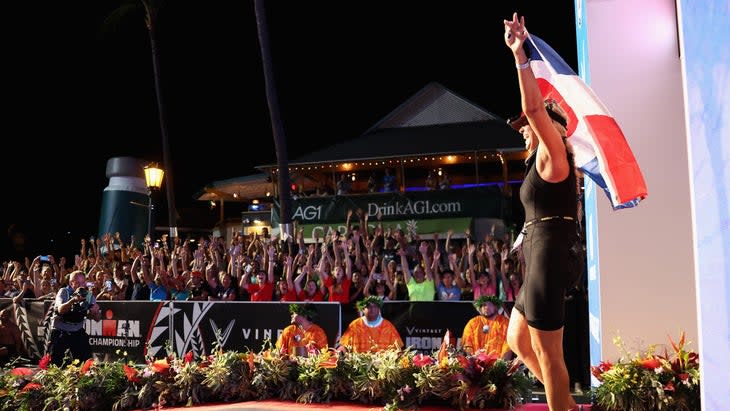
Not everyone was happy when Ironman decided to split the men's and women's world championships into separate venues this year. (The men's Ironman World Championship was held September 9 in Nice, France.) And while the aloha magic, unrivaled history, and unique brutality of the Kailua-Kona course cannot be replicated, one thing is for certain--a women's-only race leads to an unparalleled level of inspired racing.
In Ironman races with both men's and women's fields, elite and amateur women contend with men interfering with their race, whether that's getting kicked on the swim, or inadvertently earning a penalty for drafting on the bike. (And of course, these same nuisances apply to men when women are in their races.) A two-gender race also means that each gender receives less TV coverage, with the women historically receiving less than half of airtime as they battle for contention behind the men.
Giving the women a day of unfettered, fully-celebrated racing allowed the day to play out on its own terms.
"It was very nice to not have men interfering with the race," Knibb said. "And it was nice to know they weren't. It was one less worry, one less thing to think about. There's a lot of things to think about out there."
And guess what? People tuned in--a lot of people. Over 769,000 fans tuned into the 2023 women's race, up from the 599,000 who watched the men's race in Nice last month, enjoying an interrupted view as the race unfolded.
"Cameras were everywhere this year," Haug said. "Usually they're just on the first women. We put on a show today and we showed it's worth covering the whole race."
A field of 2,000-plus women also imbibed the day with a special type of comradery and grit.
"All of the pro women were cheering me on," Charles-Barclay said. "And to have their support even when we're all out there suffering just shows how amazing this sport is."
For exclusive access to all of our fitness, gear, adventure, and travel stories, plus discounts on trips, events, and gear, sign up for Outside+ today.

